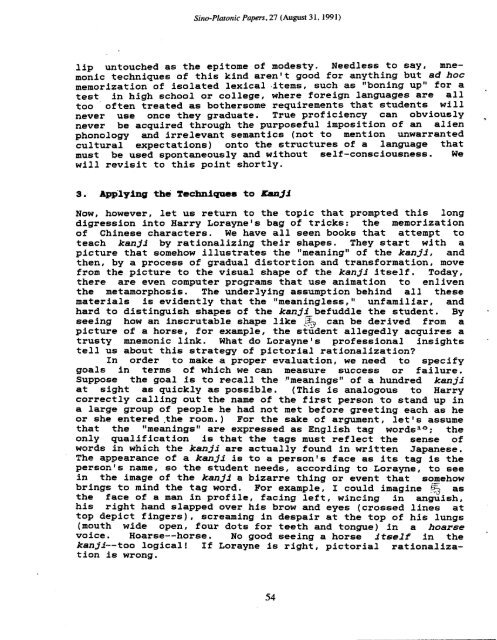Essays on Writing and Language in Honor - Sino-Platonic Papers
Essays on Writing and Language in Honor - Sino-Platonic Papers
Essays on Writing and Language in Honor - Sino-Platonic Papers
Create successful ePaper yourself
Turn your PDF publications into a flip-book with our unique Google optimized e-Paper software.
S<strong>in</strong>o-Plut<strong>on</strong>ic <strong>Papers</strong>, 27 (August 3 1. 199 1 )<br />
lip untouched as the epitome of modesty. Needless to say, mne-<br />
m<strong>on</strong>ic techniques of this k<strong>in</strong>d aren't good for anyth<strong>in</strong>g but ad hoc<br />
memorizati<strong>on</strong> of isolated lexical .items, such as "b<strong>on</strong><strong>in</strong>g up" for a<br />
test <strong>in</strong> high school or college, where foreign languages are all<br />
too often treated as bothersome requirements that students will<br />
never use <strong>on</strong>ce they graduate. True proficiency can obviously<br />
never be acquired through the purposeful impositi<strong>on</strong> of an alien<br />
ph<strong>on</strong>ology <strong>and</strong> irrelevant semantics (not to menti<strong>on</strong> unwarranted<br />
cultural expectati<strong>on</strong>s) <strong>on</strong>to the structures of a language that<br />
must be used sp<strong>on</strong>taneously <strong>and</strong> without self-c<strong>on</strong>sciousness. We<br />
will revisit to this po<strong>in</strong>t shortly.<br />
Now, however, let us return to the topic that prompted this l<strong>on</strong>g<br />
digressi<strong>on</strong> <strong>in</strong>to Harry Lorayneb bag of tricks: the memorizati<strong>on</strong><br />
of Ch<strong>in</strong>ese characters. We have all seen books that attempt to<br />
teach kanji by rati<strong>on</strong>aliz<strong>in</strong>g their shapes. They start with a<br />
picture that somehow illustrates the "mean<strong>in</strong>g" of the kanjf, <strong>and</strong><br />
then, by a process of gradual distorti<strong>on</strong> <strong>and</strong> transformati<strong>on</strong>, move<br />
from the picture to the visual shape of the kanji itself. Today,<br />
there are even computer programs that use animati<strong>on</strong> to enliven<br />
the metamorphosis. The underly<strong>in</strong>g assumpti<strong>on</strong> beh<strong>in</strong>d all these<br />
materials is evidently that the llmean<strong>in</strong>gless,ll unfamiliar, <strong>and</strong><br />
hard to dist<strong>in</strong>guish shapes of the kanji befuddle the student. By<br />
see<strong>in</strong>g how an <strong>in</strong>scrutable shape like -6 can be derived from a<br />
picture of a horse, for example, the student allegedly acquires a<br />
trusty mnem<strong>on</strong>ic l<strong>in</strong>k. What do Lorayneb professi<strong>on</strong>al <strong>in</strong>sights<br />
tell us about this strategy of pictorial rati<strong>on</strong>alizati<strong>on</strong>?<br />
In order to make a proper evaluati<strong>on</strong>, we need to specify<br />
goals <strong>in</strong> terms of which we can measure success or failure.<br />
Suppose the goal is to recall the of a hundred ken ji<br />
at sight as quickly as possible. (This is analogous to Harry<br />
correctly call<strong>in</strong>g out the name of the first pers<strong>on</strong> to st<strong>and</strong> up <strong>in</strong><br />
a large group of people he had not met before greet<strong>in</strong>g each as he<br />
or she entered ,the room.) For the sake of argument, let's assume<br />
that the "mean<strong>in</strong>gs" are expressed as English tag wordsLo; the<br />
<strong>on</strong>ly qualificati<strong>on</strong> is that the tags must reflect the sense of<br />
words <strong>in</strong> which the kanjf are actually found <strong>in</strong> written Japanese.<br />
The appearance of a kanjJ is to a pers<strong>on</strong>'s face as its tag is the<br />
pers<strong>on</strong>'s name, so the student needs, accord<strong>in</strong>g to Lorayne, to see<br />
<strong>in</strong> the image of the kanjd a bizarre th<strong>in</strong>g or event that so_mehow<br />
br<strong>in</strong>gs to m<strong>in</strong>d the tag word. For example, I could imag<strong>in</strong>e 3 as<br />
the face of a man <strong>in</strong> profile, fac<strong>in</strong>g left, w<strong>in</strong>c<strong>in</strong>g <strong>in</strong> anguish,<br />
his right h<strong>and</strong> slapped over his brow <strong>and</strong> eyes (crossed l<strong>in</strong>es at<br />
top depict f<strong>in</strong>gers), scream<strong>in</strong>g <strong>in</strong> despair at the top of his lungs<br />
(mouth wide open, four dots for teeth <strong>and</strong> t<strong>on</strong>gue) <strong>in</strong> a hoarse<br />
voice. Hoarse--horse. No good see<strong>in</strong>g a horse ftself <strong>in</strong> the<br />
kanjd--too logical! If Lorayne is right, pictorial rati<strong>on</strong>alizati<strong>on</strong><br />
is wr<strong>on</strong>g.

















